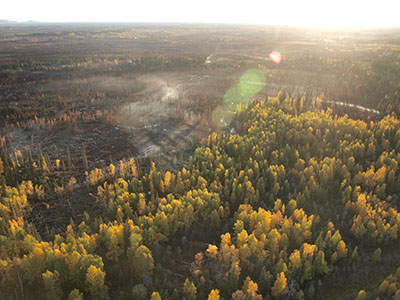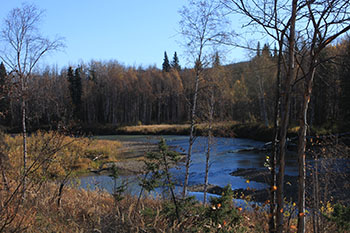Research Findings
What We Research
BNZ LTER program scientists seek to understand the interactive effects of changing climate and disturbance regimes on the Alaska boreal forest, and associated consequences for regional feedbacks to the climate system, and sustainability of subsistence Alaskan communities.
The Question
We want to know how Interior Alaska as a coupled social-ecological system is responding to environmental change. One focus is on understanding the mechanisms that contributed to this region's resilience for thousands of years. Another focus is to characterize current and projected patterns and vulnerabilities to both gradual and threshold changes in ecosystems and landscapes. The project to answer this question was structured around the four integrated sections below.
Summary
Alaska has warmed more than twice as rapidly as the contiguous United States during the past century, with some of the largest annual air temperature increases occurring in Interior Alaska's boreal forests. This warmer and drier climate has triggered unprecedented changes in the fire regime and permafrost thaw. Species ranges are shifting and the structure and functioning of ecosystems across the boreal landscape are experiencing major alterations. Access and use of ecosystem services such as wildlife, wildfoods, water, and recreation are also affected.

Warming has been driven primarily by anthropogenic emissions of greenhouse gases at the global scale, but is amplified at high latitudes (Fairbanks, Alaska 64.8436° N, 147.7231° W) by energy and trace-gas feedbacks resulting from fire, melting of sea ice and glaciers, lengthening of the snow-free season, and atmospheric losses of previously frozen permafrost carbon as carbon dioxide and methane.
What have BNZ scientists discovered?
Effects of Climate Change
- Boreal Browning. The boreal forest is browning throughout Interior Alaska. Reduced basal increment growth and a change in carbon-13 enrichment of tree rings of white and black spruce over the past 100 years are consistent with satellite-derived declines in forest productivity and the "browning" of the boreal forest throughout Interior Alaska.
- Growth Thresholds. The occurrence of thresholds in growth indicate that small changes in climate may have disproportionately large effects on forests in Interior Alaska.
- Ecotone Shift. Increased tree growth in wetter regions of western Alaska, coupled with range expansion of conifers into both northern and western tundra regions, and the spread of deciduous forests following fire suggest a regime shift in vegetation community composition across the boreal forest.
- Phenological Niche. Long-term monitoring indicates that as climate warms and the snow-free period increases, there is a vacant phenological niche in fall but not in spring, and non-native plants may be able to fill this niche.
- Permafrost Temperatures Rising.
 Long-term monitoring indicates that permafrost temperature near Fairbanks, Alaska, warmed considerably from the mid-1960s to mid-1990s, then cooled slightly due to lower temperatures and less snow, but have shown increases over the past decade, interrupted by a late snowfall in 2006.
Long-term monitoring indicates that permafrost temperature near Fairbanks, Alaska, warmed considerably from the mid-1960s to mid-1990s, then cooled slightly due to lower temperatures and less snow, but have shown increases over the past decade, interrupted by a late snowfall in 2006.
Climate Disturbance
- Wildfire Intensity. Wildfires are intensifying in boreal forests.
- Wildlife Population Changes. Vegetation changes resulting from warming and altered disturbance regimes are influencing vertebrate herbivore populations, including caribou, moose, ptarmigan and snowshoe hares.
- Snowshoe Hare. The decadal population cycle of snowshoe hares in Interior Alaska represents a 20-fold variation in hare density, which is accompanied by strong demographic effects on their mammalian and avian predators. Hare populations appear to be controlled by an interaction of food supply and predation as evidenced by survival being best explained by body condition superimposed on season and habitat use.
- Stream Hydrology.
 Stream hydrology and chemistry are tightly coupled to fire frequency and severity, and the distribution of permafrost, which influences watershed flowpaths through catchments. Streams draining watersheds with extensive permafrost have flashier and greater variation in stream flow than streams draining watersheds lacking permafrost. Moreover, based on stream flow data collected from BNZ watersheds since 1978, stream flows have become less responsive to rain storms, presumably due to loss of permafrost and the effects on water routing to streams
Stream hydrology and chemistry are tightly coupled to fire frequency and severity, and the distribution of permafrost, which influences watershed flowpaths through catchments. Streams draining watersheds with extensive permafrost have flashier and greater variation in stream flow than streams draining watersheds lacking permafrost. Moreover, based on stream flow data collected from BNZ watersheds since 1978, stream flows have become less responsive to rain storms, presumably due to loss of permafrost and the effects on water routing to streams
Ecosystem Dynamics
- Area Burned. About 85% of fire activity in Alaska occurred in the northern boreal region between 1950 and 2009 and the number of fires averaged 32/year and ranged as high as 137 in 2005. The annual area burned averaged 3,262 km2 per year (0.7%) in northern boreal Alaska. The interannual variability in area burned is substantial and ranged as high as 26,684 (6%) in the northern boreal region in 2004.
- Carbon Source. Between 1950 and 2009, the Dynamic Organic Soil Terrestrial Ecosystem Model (DOS-TEM) estimates that the northern boreal region of Alaska was a carbon source of 7.9 teragrams/year because of large carbon losses from wildfire, specifically during large fire years in 1956, 1969, 1977, and in the 1990s and 2000s.
- Vegetation & Carbon. Vegetation carbon stocks are projected to increase throughout the 21st century for the six climate scenarios for the northern boreal region of Alaska because of responses to longer growing seasons, increased soil N availability, and atmospheric carbon dioxide fertilization. The DOS-TEM estimates that increased inputs to the soil from projected increases in net primary production (NPP) more than offset carbon losses from thawing permafrost so that soil carbon increases in all scenarios.
- Methane. Methane (CH4) emissions ranged from little change to a tripling across climate scenarios, so that there was variability across scenarios as to whether the northern boreal region of Alaska would enhance or mitigate greenhouse gas forcing of the climate system.
Social-Ecological Dynamics
- Agent-Based Model. BNZ LTER advanced resilience science through partnerships in knowledge co-production and the development of an agent-based model (ABM) that projects future interactions and trade-offs at the household and community levels. Although a mixed economy built on a basic tradeoff that redistributes wild foods from successful hunters to the broader community persisted through time despite greater engagement of community members in a cash economy, it was less resilient to accumulated perturbations.
- Community Observations. Predominant observations of landscape change and findings from active harvesters and elders that correspond strongly to field measurements made during the past 50 years include:
- Widespread river bank erosion
- Lake drying
- Increases in the frequency and intensity of fires
- Fewer waterfowl and muskrats
- Smaller and fewer King salmon
- Fewer villagers involved in subsistence
- Overall increase in non-local hunters
- Camera-Equipped GPS. BNZ LTER recently innovated methods of community-based ecological monitoring by issuing camera-equipped GPS units to subsistence harvesters in six Interior Alaskan subsistence communities. Harvesters documented their observations of landscape change, with images and locations posted online using Storybook*. Of particular interest is how landscape changes are affecting harvesters’ access to traditional-use areas. *For more information on Storybook, contact Professor Gary Kofinas or Assistant Professor Todd Brinkman.
 B
B

